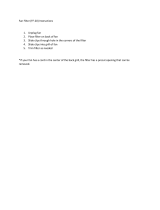
2
Important Safety Instructions
• If you receive a damaged product, immediately contact your dealer. Do
not install or use a damaged appliance.
• Have the installer show you the gas shut-off valve and electrical outlet so
you turn off the gas and disconnect power to the range as needed.
• Do not install/repair/replace any part of the range unless as instructed in
the range literature. A qualified technician should do all other service.
• Before any type of service, turn off the gas, and unplug the range.
• Only use this range for residential cooking tasks only. This range is not
intended for commercial use and is certified for indoor use only.
• DO NOT TOUCH THE COOKTOP, BACKGUARD, AND SURROUNDING
SURFACES DURING OR IMMEDIATELY AFTER USE.
• Ensure all users can operate the range properly.
• Never let anyone sit/stand/climb on any part of the range.
• Do not leave children/pets unattended near the range. Do not let children
to play with the any part of the range.
• Do not store items of interest to children on/near the range.
• Do not try to use the range during a power failure. If a power failure
occurs while using the cooktop, turn off all active controls.
• Keep flammable items away from burners and hot surfaces.
• Do not tamper with the controls.
• Do not hang flammable or heat-sensitive objects over the range.
• Do not heat sealed containers.
• Put only proper cookware on grates; decorative covers can be a fire
hazard or may damage a burner that is turned on with the cover in place.
• Never use the range without the knobs or trim rings in place.
• Do not wear loose/hanging apparel while or just after using the range.
• Do not use towels or bulky cloth as pot holders.
• Use only dry pot holders. Wet pot holders can cause steam burns.
• Do not hang curtains that could blow over the cooktop.
• Never leave burners unattended at high-heat settings.
• Clean the range thoroughly before operating it for the first time.
• Clean/maintain the range regularly as instructed in this manual. Keep the
entire range, ventilation filters and range hoods free of grease.
• Check cookware manufacturer instructions to determine suitability for
range use. Certain material is unsafe for range use.
• NEVER block slots/holes/passages anywhere on the range. Doing so
prevents efficient and safe operation.
• Very cautiously add water to food in hot cookware.
• Use cookware of proper size/material/construction for the cook task. Do
not overfill cookware. Pans should not be unwieldy and should have solid,
easy-to-hold handles that stay cool while cooking.
• Do not allow pots or pans to boil dry.
• Ensure all cooktop parts are dry before lighting a burner.
• Turn off burners before removing the control knobs.
• Do not use the oven for storage.
• When opening the oven door, stand aside so hot air and steam can
escape safely.
• Do not use the oven without the convection filter installed. Spinning
convection-fan blades are a safety hazard.
• Do not leave food in the oven more than 1 hour before/after cooking.
• When deep-fat frying:
- do not overfill the pot, causing a boil-over from bubbling oil
- heat oil slowly, andnever leave the pot unattended
- do not fry moist or frosty food
- stir together combined oils/fats before heating
- use a frying thermometer to avoid heating oil beyond its flash point.
• Tip-over hazard:
- Any-size person can tip the range and be killed.
- Ensure the anti-tip bracket is properly installed per the
installation instructions.
- After moving the range, ensure anti-tip foot re-engages the
anti-tip bracket as shown below; do not use the range if the
anti-tip foot does not engage the anti-tip bracket.
• The range has a 3-prong grounding plug to protect against possible
electric shock. The owner shall ensure that a dedicated, grounded
3-prong electrical outlet is available. Never:
- remove the cord’s third (ground) prong
- use an adapter plug
- use an extension cord
- use a damaged power cord
- use a ground fault interrupter (GFI).
IN THE EVENT OF A RANGE TOP GREASE FIRE:
• Being careful not to burn yourself, smother flames with a close-fitting lid,
cookie sheet, or metal tray, then turn off the burner. If the flames do not
go out immediately, EVACUATE AND CALL THE FIRE DEPARTMENT.
• NEVER PICK UP A FLAMING PAN.
• DO NOT DOUSE FLAMES WITH WATER OR WET CLOTH.
• Use a fire extinguisher ONLY if:
- you have a Class ABC extinguisher and know how to use it.
- the fire is small and contained in the area of origin.
- the fire department is being called.
- you can fight the fire with your back to an exit
.
• Quickly wipe acids (citrus juices, tomato sauces, etc.) from range surfaces.
• Never use the cooktop surface as a cutting board.
• Do not remove heavy spills with a sharp or metal object.
• Do not line the oven with foil or other materials. These items can melt or
burn up during self cleaning, permanently damaging the oven.
• Do not expose the knobs or trim rings to direct flame, hot utensils, or
other heat sources.
• The light-fixture lens cover must always be in place to keep the light bulb
from breaking due to oven heat and mechanical shock.
• Non-stick coatings, when heated, can be harmful to birds. Relocate them
to a separate, well-ventilated room during range use.
WARNING
WARNING
CAUTION
General Safety Precautions
To reduce risk of fire, serious injury, or death in using the range, follow basic safety precautions, including:





















